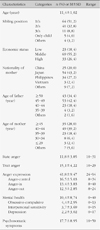Abstract
Purpose
The purpose of this study was to identify the relationship of anger, and its expression type to mental health and psychosomatic symptoms in children of multi-cultural families.
Methods
The data were collected from 125 students in grades 4~6, and analyzed using descriptive statistics, cluster analysis, t-test, ANOVA, Tukey's multiple comparison test were used with the SPSS/WIN 12.0 program.
Results
Three anger-expression types were found; low anger expression, anger-out, anger-control/in type. There were significant difference in mental health and psychosomatic symptoms between the upper 25% and lower 25% groups of state-trait anger. Also, levels of state-trait anger and types of anger expression were associated with mental health and psychosomatic symptoms.
Figures and Tables
Table 1
General Characteristics of the Participants and Descriptive Statistics of Research Variables (N=125)

Table 3
Correlation between State Anger, Trait Anger, Anger Expression, and Dependent Variables (N=125)

References
1. An HJ. A study on school adjustment and mental health in elementary school children from multicultural families in a rural city. J Korean Acad Psychiatr Ment Health Nurs. 2008; 17:383–391.
2. Baik MJ. A study on school aged children's anger by social classes. Seoul: Sookmyung Women's University;2002. Unpublished master's thesis.
3. Deffenbacher JL, Lynch RS, Oetting ER, Kemper CC. Anger reduction in early adolescent. J Couns Psychol. 1996; 43:149–157.
4. Derogatis LR, Rickels K, Rock AF. The SCL-90 and MMPI. Br J Psychiatry. 1976; 128:280–289.
5. Everson SA, Goldberg DE, Kaplan GA, Julkunen J, Salonen JT. Anger expression and incident hypertension. Psychosom Med. 1998; 60:730–735.

6. Freeberg S. Anger in adolescence in children and adolescents. Am J Psychother. 1982; 21:565–574.
7. Gottlieb MM. The angry self: A comprehensive approach to anger management. NY: Zeig, Tucker & Theisen;1999.
8. Hill EH, Grammatteo MC. Socio-economic status and its relationship to school achivement in elemenatary school. J Elem Educ. 1963; 40:266–270.
9. Jeollanam-do. A study on foreign immigrated wives and children in Jeollanam-do. Jeollanam-do: Author;2006.
10. Kang IS. The relationship between stress related with extracurricular activities and mental health of elementary school students. Gwangju: Gwangju University;2004. Unpublished master's thesis.
11. Kim HS, Kim HS. Development of instrument for measuring personality factor related to juvenile delinquency. J Korean Acad Psychiatr Ment Health Nurs. 1999; 8:190–201.
12. Kim KH, Chon KK. Effects of anger, hostility and stress on physical health. Korean J Health Psychol. 1997; 2(1):79–95.
13. Kim KI, Kim JH, Won HT. Korean manual of symptom checklist-90-revision. Seoul: Chungang Aptitude Publishing;1984.
14. Korea Institute for Health and Social Welfare. The health and welfare policy for multicultural age-focusing on multicultural family (study report 2008-14). Seoul: Author;2008.
15. Lee YS, Cho JY. A standardization study of the Korean version of the adolescent's state-trait anger expression inventory. J Korean Neuropsychiatr Assoc. 1999; 38:794–804.
16. Ministry of Education, Science, and Technology. (2008). A study on the current situation of multiculutural family children. Retrieved June 18, 2008. from http://www.mest.go.kr.
17. Ministry of Justice. Immigration bureau, annual report on the international migration statistics of Korea immigration service. Kyunggi-do: Author;2009.
18. Ministry of Public Administration and Security. 2009 Local government: Survey results of foreign residents. Seoul: Author;2009.
19. Moon SH, Chung YH, Kim JH. The relation of anger and anger expression to eating disorders in late school-age children. J Korean Acad Child Health Nurs. 2009; 15:127–135.

20. Muris P, Meesters C, Morren M, Moorman L. Anger and hostility in adolescents: Relationships with self-reported attachment style and perceived parental rearing styles. J Psychosom Res. 2004; 57:257–264.

21. Oh SB. The implication of the 'Kosian' case for the multicultural education in Korea. Korean J Sociol Educ. 2006; 16(4):137–157.
22. Park YJ, Park ES, Kim SJ, Yang SS, Shin HJ, Im HS, et al. Anger and health status in late school-age children. J Korean Acad Nurs. 2005; 35:888–895.

23. Pennebaker JW. Confiding traumatic experiences and health. In : Fisher S, Reason J, editors. Handbook of life stress, cognition and health. NY: Wiley;1988. p. 669–682.
24. Seo H, Lee SE. A study on the difficulties of children from international marriage families in agricultural regions. J Korea Open Assoc Early Child Educ. 2007; 12(4):25–47.
25. Sharkin BS. The measurement and treatment of client anger counseling. J Couns Dev. 1988; 66:361–365.
26. Smokowski P, Mann EA, Reynolds AJ, Fraser MW. Childhood risk and protective factors and late adolescent adjustment in inner city minority youth. Child Youth Serv Rev. 2003; 26:63–91.

27. Solomon EP. An examination of personality characteristics and coping mechanism identified as putative risk factors. Tampa, USA: University of South Florida;1987. Unpublished master's thesis.
28. Song SH, An HJ. Experience of child-rearing of Filipino married immigrant women. J Korean Acad Psychiatr Ment Health Nurs. 2011; 20:167–179.

29. Spielberger CD. Professional manual for the State-Trait Anger Expression Inventory (STAXI). Tampa, FL: Psychological Assessment Resources;1988.




 PDF
PDF ePub
ePub Citation
Citation Print
Print





 XML Download
XML Download